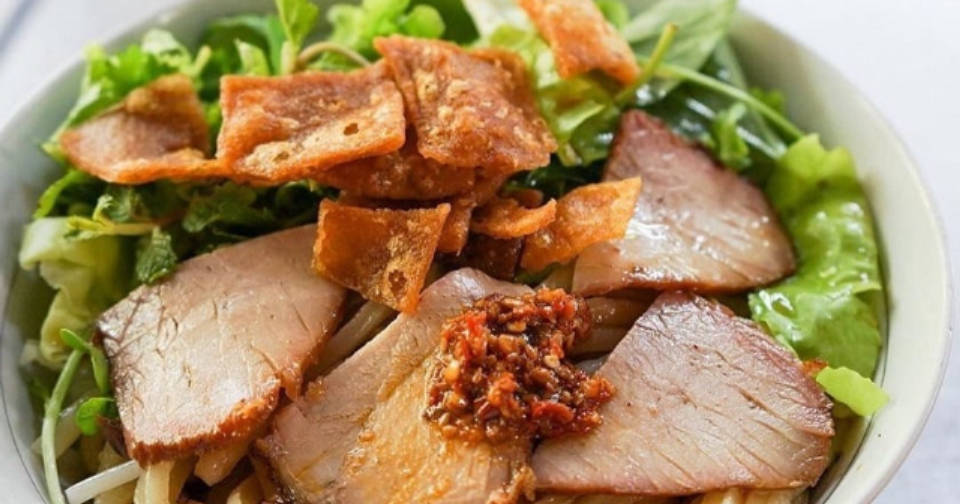When visiting Hoi An, in addition to enjoying the ancient beauty of the streets with hundreds of years old houses or traditional craft villages with talented artisans, visitors can also enjoy the specialties of this land. Among them is a very unique dish called Cao Lau, once considered a delicacy reserved only for the rich and the upper class in society.
When visiting Hoi An, in addition to enjoying the ancient beauty of the streets with hundreds of years old houses or traditional craft villages with talented artisans, visitors can also enjoy the specialties of this land. Among them is a very unique dish called Cao Lau, which was once considered a delicacy only for the rich and the upper class in society. Today, Cao Lau has become popular with all locals and tourists. This dish is associated with the ancient town when people mention Hoi An.
Cao Lau has appeared in the old town since the 17th century, when Hoi An port was opened. Hoi An ancient town was a bustling international trading port - a meeting place for Japanese, Chinese and Western merchant ships. In the past, merchants in the port town, wanting to look after their goods, often climbed to the top floor of the restaurant to eat while protecting their goods or monitoring the activities of their workers. And the name "Cao Lau" also started from there. But there is also a hypothesis that: Cao Lau was once a "delicacy" only served to the rich or those of high position, so they often sat on the top floor, eating while enjoying the activities on the street. Therefore, this dish was called "Cao Lau" by the people.
The process of making Cao Lau noodles is very elaborate. At first glance, we can see that Quang noodles and Cao Lau noodles are quite similar as they are both made from the same ingredient, rice flour. However, Quang noodles are simply made from thinly spread rice flour and steamed, while Cao Lau noodles are made through many stages and are much more elaborate. First, fragrant rice must be soaked in cajuput wood ash water, taken from Cu Lao Cham land, only then will the noodles be chewy, soft and crunchy. After being carefully filtered, the rice must be ground with Ba Le well water. Local people believe that the well water here is not alum and is cool, so the noodles can be sweet and dry as desired. In the process of making Cao Lau noodles, the way to knead the dough to be chewy but dry is the most important secret, determining the quality of the product. Unlike noodles, pho, and rice paper, people do not make Cao Lau by spreading the dough. After kneading, the Cao Lau dough is rolled out thinly and then steamed. When cooked, the dough is cut into large strands. After being processed many times like this, even if the Cao Lau noodles are left overnight, they will not spoil.
Next is the rich and distinctive sauce that creates the flavor of this dish. Unlike Quang noodles, vermicelli or pho with a lot of broth, Cao Lau only uses a thick sauce. This sauce is taken from the process of making pork belly which takes a lot of time. Initially, the pork is marinated with five-spice powder, shallots, pepper, soy sauce, sugar and seasoning powder for 3 to 4 hours. Then, the garlic is fried in peanut oil and the meat is cooked over low heat until the meat is tender and the sauce thickens. The pork belly is sliced into thin, bite-sized pieces and the sauce is used to mix into the Cao Lau noodles. It is accompanied by fried pork fat, fresh herbs from Tra Que vegetable village and blanched bean sprouts. Nowadays, fried crispy pork fat is also replaced with fried Cao Lau noodle flour. In addition, to make Cao Lau more delicious, people also add crushed roast peanuts. These are placed on the Cao Lau noodles very beautifully and create an attractive aroma for diners.
Here are 5 famous Cao Lau restaurants in Hoi An that you should try:
-
Cao Lau Co Lien (16 Thai Phien).
-
Ms. Thanh's Cao Lau (26 Thai Phien)
-
Cao Lau Green Space (687 Hai Ba Trung)
-
Cao Lau Ba Be (Hoi An Market Food Court)
-
Tyty Quan (17/6 Hai Ba Trung)
 Register
RegisterSign in Travel Agent
Sign in Supplier
Sign in Affiliate
Sign in Guru

